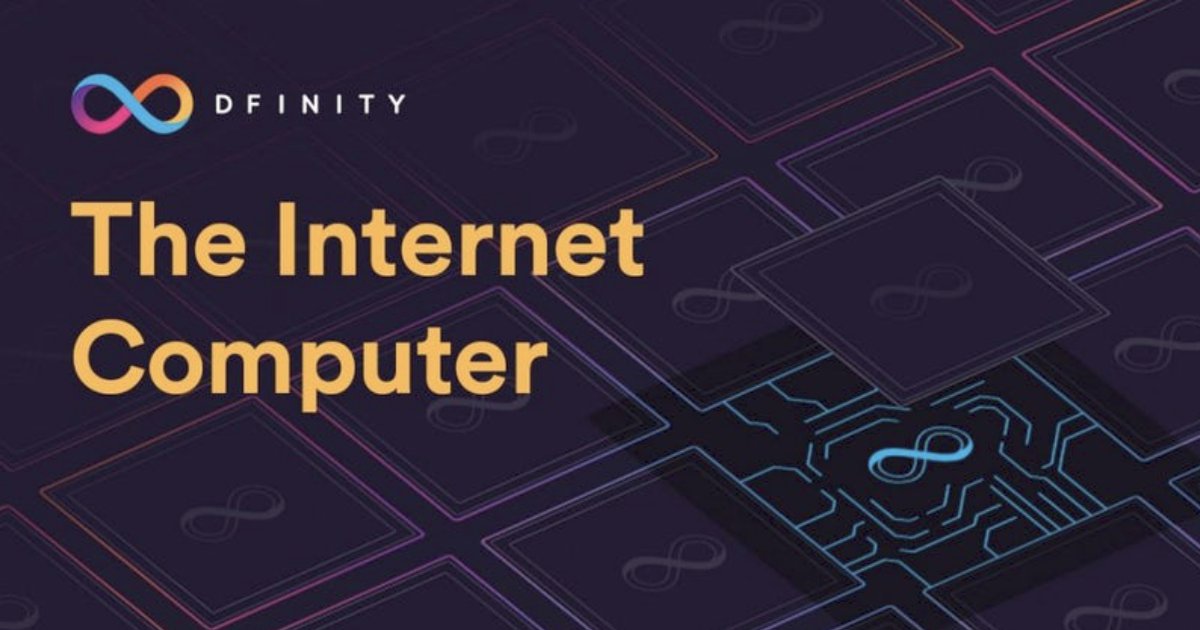
Table of contents
- Traditional internet
- Web3
- The Internet Computer
- Fully on-chain
- dApps on IC
- Voting and community
- Conclusion
As I have spent most of my career in the traditional internet environment, the internet as we all know it, I have recently discovered a new platform called The Internet Computer (IC) that totally caught my interest. In this article, I am going to explain the potential of the IC in the least technical way possible so the broadest audience and people new to the blockchain space can understand.
Traditional internet
First off, to get some contrast, I would like to talk about traditional internet and about Web 3. Let’s ask ourselves a question – is there is any problem with our current internet? Well, it depends on how critically are you looking at it or what are your priorities. I’ve been riding a wave of the internet & social networks without any issues in the past too.
Data privacy
Through the time, I started noticing an increasing amount of ads and it made me thinking about where all of these money goes and what happens to our data. As a Head of Data in a marketing company, I have a pretty good technical understanding of how user tracking across websites works. With a little of imagination, I can see how bad it can go if a few companies conquer the whole space and are controlling the whole internet.
Imagine that you take all of the data that you put to social media (Facebook, Instagram, WhatsApp) in a combination of what you do elsewhere on the internet and where you move in a real world. And this data is reportedly monetised and used for bad stuff (political propaganda etc.) you can read about it here.

Censorship
And there are other things. Censorship is one to mention. I am pretty sure most of you remember what happened after Trump’s Twitter account got banned. I don’t want to start a discussion whether or not it was right to block it (I am not a supporter of Trump myself). The question is who decides?
After Trump has moved to another social network called Parler (a censorship resistant alternative to Twitter), the whole site was then completely shut down – site backend on Amazon Web Services, mobile apps taken down from AppStore and Google Play. You can read about it here.
In fact, majority of the websites today are hosted on the servers of Amazon, Google or Microsoft and few others. This website runs on Google servers too by the way :). Anyway, Trump & Parler was the most visible case lately, but I am seeing censorship in action between normal people all around quite often...
These were a few examples of what can go wrong if the majority of the internet is in the hands of a couple of CEOs from centralised companies like Facebook, Amazon, Google… Besides the whole business model of making tones of money on the users and not giving anything in return doesn’t feel quite right. Internet Computer seems like to be showing us a better way. Carry on reading to find out.
Web3
I am pretty sure you have heard about the term “Web3” lately as it is a very hot and hyped topic in the world right now in connection with NFTs (non fungible tokens). If Web3 is above your understanding, here goes quick explanation.
Let’s start with Web1. It was the very first era of internet where all of the websites were just a static content, you could click on links, read text and pictures and that was all. Web2 brought the interactivity into play. It was the beginning of social networks as we know them today. You could share and like posts and stay in touch with your friends. As I mentioned above, Web2 was quickly conquered by a couple of big tech giants.
Web3 is bringing an idea that all of the content and dApps (decentralised apps) are going to be in the hands of it’s users. Users will decide what is going to happen with the dapp in the future. Users will financially benefit from using the dapp if there is any form of monetisation. Creators can freely distribute their art without being under control of any intermediaries… Possibilities are endless.
The Internet Computer
So we finally made it to the main point of this writing – what is the Internet Computer (IC) and how can it make the vision of Web3 to become real.
In a short form of explanation, the IC is a new generation of blockchain. Deep explanation of what blockchain is is beyond the scope of this text, but to give you a quick start let’s begin with Bitcoin. Bitcoin was the first invention of cryptocurrency, basically it became a form of digital money as it allows us to store coins and send transactions through the network. The most key point here is that it's a decentralised network of nodes – no individual, single company or government can change it or stop it. Only if majority of the participants, in this case miners, decide to manipulate it, they can.
The second invention was a project called Ethereum. Some people saw more possibilities that could be done with blockchain technology and felt that Bitcoin is very limited. So they came up with an invention called smart contracts. Again, in a very primitive way of explanation, you can think of smart contracts as set of rules that can be coded and executed in the blockchain. It opened a lot of possibilities especially in the world of DeFi (decentralised finance) where developers created decentralised form of financial instruments that we know from traditional world of finance.
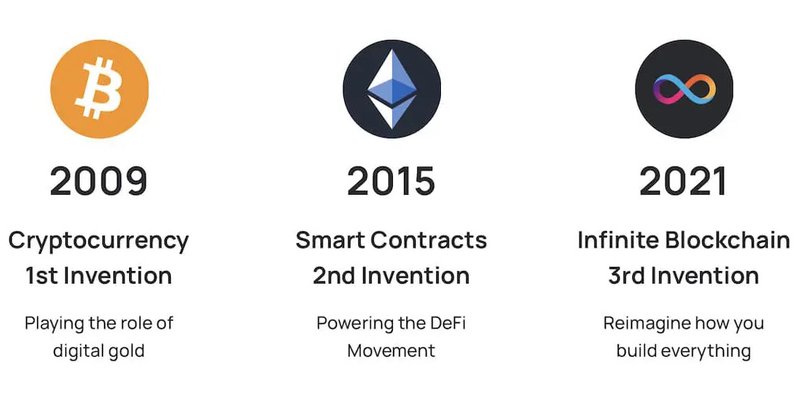
Although Ethereum was successful in it’s mission and it quickly became the second largest crypto project, Dominic Williams, the inventor of the IC, felt that more could be achieved as Bitcoin and Ethereum are both slow, not scalable and expensive to use networks.
He started Dfinity Foundation and it took them 5 years and an enormous effort of 200 people to develop it. Their team consists of several world class cryptographers, distributed systems engineers and blockchain specialists. Many of them are former employees of big tech companies. In may 2021, they finally launched the project and opened it for public.
Fully on-chain
So what is the actual innovation that IC brought to the space? The speed of this network is insane – you can send a transaction or an update call in 2 seconds and you can read data in terms of milliseconds. The cost of transaction is also very low, currently 0.0001 ICP. In comparison to Ethereum – one transaction can cost more than 20 USD and can take longer than 20 minutes to update. It’s a huge improvement!
High speed and low cost are one side. But in my eyes the biggest innovation is that everything is running fully on-chain. The code of the dApp, static files and media files are bundled together into a form called canisters and are served to the web. This means that you can interact with the dApp directly via web browser, running the same speed that you are used to and it all happens in a completely decentralised manner with stronger security than traditional internet. Running fully on chain, both computing and storage, was not possible before the IC.
Reversed gas model
Above that, users don’t have to pay to interact with the network as is common with Ethereum and other blockchains. There is a reversed gas model – the ones that runs the dApp are responsible to pay for it’s usage, not the users. ICP token can be transformed into Cycles that are used to pay for dApp's traffic. The more usage and adoption dApps running on the IC get, the more ICP is going to get burned. Tokenomics of this project is also very cool, you can read more about it here.
Network
Similarly to other blockchains, the Internet Computer network consists of multiple independent data-centres. These data-centres are connected with the Internet Computer protocol. No single data-centre can take over the network. Nodes are grouped into subnets and each subnet is hosting multiple canisters mentioned above. These canisters run in parallel and the whole IC network can easily scale by adding more subnets to it.
Thanks to the IC, we have a network that:
- is decentralised
- fast and scalable
- can server web content
- computation and data on chain
- running autonomous smart contracts
- governed by it's users
In the end, the Internet Computer is not only a blockchain, it is the whole infrastructure where you can host your websites or web (d)applications. They are aiming to be a decentralised competitor to corporate cloud providers such as AWS or Google Cloud.
dApps on IC
This is not only a theory, there are already real running projects on the IC. What I like the most about the IC is that they really deliver, not just like some other blockchains that only promise. I can name several examples of dApps that I have been experimenting with past weeks:
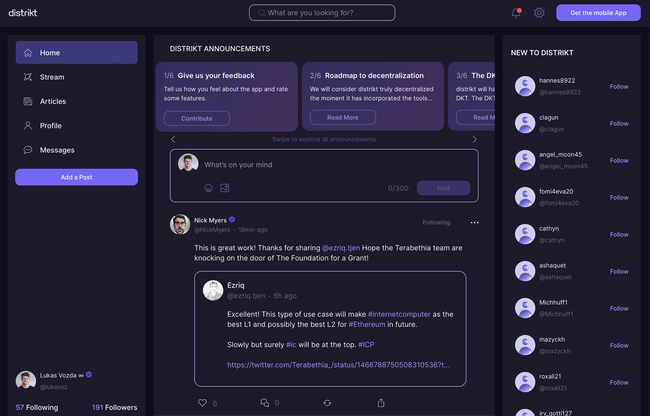
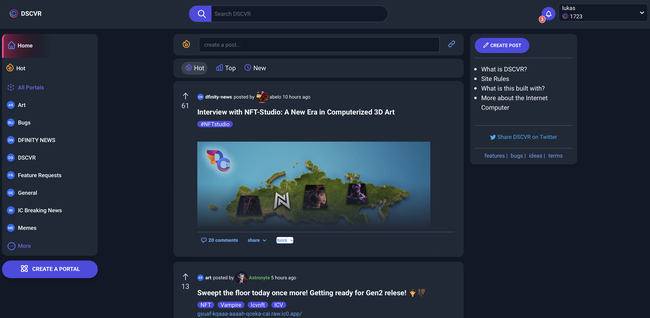
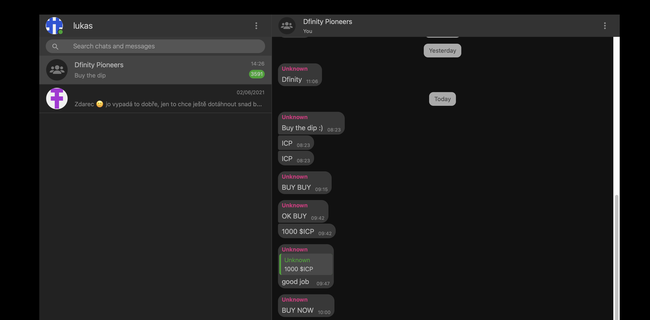
DSCVR
Discover is a Web3 alternative of Reddit, running completely on-chain. You can visit it on this link, it works without registration dscvr.one. All the posts that you see on the website are served directly from the blockchain. Insane, right?
Distrikt
Distrikt is my next favourite example. You can visit distrikt.io, in this case you need to create an account (Internet identity) to use it. To me, distrikt is a combination of Twitter and LinkedIn. Very nice design, working smooth... By the way, it has more than 20 000 active users right now and has been running for 4 months already. It only cost about 100 USD in Cycles to run it. It is actually cheaper than running it on Google Cloud.
Open Chat
Open chat is a decentralised version of WhatsApp running entirely on the IC. You can send messages, pictures or create group chats. In the next release you will be able to send tokens or NFTs with a speed that you are normally used to. You can try Open chat here oc.app.
And this is just a small sample. There is a plenty of other projects such as games, NFT marketplaces or tools. And the party is just getting started. You can check more apps on this site.
There are other projects and platforms that try to look like they are doing the same but they are not. Most of them are running only partly on-chain and still hosting front ends on the AWS or storing files in corporate cloud which makes them as well as vulnerable and imperfect as traditional projects. Fully on chain is a key here.
Voting and community
The whole network is governed by NNS (the network neuron system). Simply said it is a place where every ICP token holder can create a neuron and then vote for new updates and features that are going to be implemented. They are also preparing a new form named SNS (service neuron system) which is an alternative for dApps. When it get's ready, users of dApps will be also able to vote for a specific dApp development not only for the IC as the whole network. It means that dApp will be able to completely separate from it's founders and run fully autonomously, governed by the community.
This is going to bring new opportunities for dApp governance and funding, better alternative to the ICO model that gained very negative reputation in the past.
There is a lot of upcoming updates for example a native integration of Bitcoin – you will be able to send BTC natively on the IC, no bridge, no wrapping. Ethereum integration will follow. Also, the community is getting ready a proof of humanity update, which will allow to give more voting power to real people and limit bots and fake accounts.
Internet identity
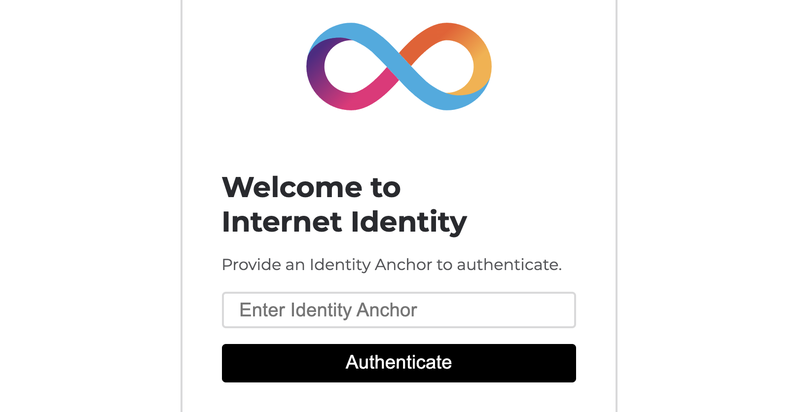
In order to vote in the NNS or log in to dApps. You need to create your Internet Identity (II). II is another invention of the IC and is a replacement to the legacy e-mail and password login system that is very inconvenient. You can log in to II using your fingerprint sensor on your Mac or FaceId on your phone. Also you can buy a hardware Yubikey as a backup. II is another improvement that gives you more secure and private way to interact with dApps.
You can create your Internet Identity here identity.ic0.app.
Community
The IC community is full of very talented developers. I have joined multiple discussions that they hold almost every week and was surprised how friendly and cooperative these people are. There is no EGO and no hype which is very rare in the world of crypto. Everyone is just working hard to push the IC forward and to improve this beautiful technology.
Conclusion
You are probably starting to realise what kind of revolution this can be. Above the Dfinity foundation that has been developing the IC so far, there is already more than 1000 developers from outside, working on their own projects and more are coming every week.
There is still a lot work that need to be done and it will take some time (probably years) for massive adoption, but I can already see a bright future for this platform. I hope they will keep up doing all the good work.
This is all from my side. I tried to explain everything in the most natural way. However, it was not completely easy as it is quite technically complex topic and I have spent myself more then 100 hours studying it. Anyway, for those of you that would like to learn more, here are some links:
- Dfinity page dfinity.org
- Documentation smartcontracts.org
- Dfinity Youtube channel with all the previous community conversations youtube.com